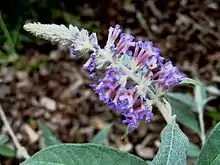Buddleja fallowiana
Buddleja fallowiana is a species of flowering plant in the Scrophulariaceae family.[1] It is endemic to the Yunnan province of western China, where it grows in open woodland, along forest edges and watercourses.[2] The plant was collected in China by Forrest in 1906, and named in 1917 by Balfour & Smith for George Fallow, a gardener at the Royal Botanic Garden Edinburgh who had died in Egypt in 1915 from wounds sustained fighting in the Gallipoli Campaign.[3]
| Buddleja fallowiana | |
|---|---|
 | |
| Scientific classification | |
| Kingdom: | Plantae |
| Clade: | Tracheophytes |
| Clade: | Angiosperms |
| Clade: | Eudicots |
| Clade: | Asterids |
| Order: | Lamiales |
| Family: | Scrophulariaceae |
| Genus: | Buddleja |
| Species: | B. fallowiana |
| Binomial name | |
| Buddleja fallowiana | |
| Synonyms[1] | |
| |
Description
Buddleja fallowiana is a deciduous shrub typically growing to a height of 4 m (13 ft); of loose habit, the young shoots are clothed with a dense white felt. The ovate to narrowly elliptic leaves are 4 – 13 cm long by 1 – 6 cm wide, acuminate or acute at the apex; the upper and lower surfaces densely tomentose, bestowing a silvery grey sheen. The inflorescences are slender thyrsoid, sometimes interrupted, panicles at the ends of the current year's shoots, 5 – 15 cm long by 2 – 3 cm wide, comprising fragrant lavender - blue flowers with orange throats, the corollas 2 – 3.5 mm wide by 9 – 14 mm long with erect lobes. The flowers bloom in late summer and autumn.[4]
Growth is significantly slower than that of B. davidii; Bean considered the species more closely allied to B. nivea,[2] although its chromosome number, 2n = 76 (tetraploid), places it alongside the similarly tetraploid B. davidii.[5]
Cultivation
Somewhat tender, B. fallowiana is best grown against a wall. However, if cut to the ground by frost, it will grow again from the base. Hardiness: USDA zones 8–9.[6]
Varieties
The variety was considered horticulturally superior to B. fallowiana by Bean, who thought it one of the most attractive of all Buddlejas;[2] it was accorded the Royal Horticultural Society's Award of Garden Merit in 1993.[7] However, its varietal status was challenged by Leeuwenberg, who considered its colouration insufficient to justify it as a variety, and sank it as simply B. fallowiana.[4]
Hybrid cultivars
A number of hybrid cultivars have been raised, invariably through a crossing of the species with Buddleja davidii:
References
- "Buddleja fallowiana Balf.f. & W.W.Sm". Plants of the World Online. The Trustees of the Royal Botanic Gardens, Kew. n.d. Retrieved August 3, 2020.
- Bean, W. J. (1917). Trees and shrubs hardy in Great Britain, 7th edition. Murray, London.
- Sabourin, L. (1929). Le Buddleja fallowiana et sa variété alba. Revue Horticole, pp. 418-420, Vol. 101. 1929.
- Leeuwenberg, A. J. M. (1979) The Loganiaceae of Africa XVIII Buddleja L. II, Revision of the African & Asiatic species. H. Veenman & Zonen, Wageningen, Nederland.
- Chen, G, Sun, W-B, & Sun, H. (2007). Ploidy variation in Buddleja L. (Buddlejaceae) in the Sino - Himalayan region and its biogeographical implications. Botanical Journal of the Linnean Society. 2007, 154, 305 – 312. The Linnean Society of London.
- Stuart, D. D. (2006). Buddlejas. RHS Plant Guide. Timber Press, Oregon. ISBN 978-0-88192-688-0
- "RHS Plant Selector - Buddleja fallowiana var. alba". Retrieved 15 April 2020.
- Li, P. T. & Leeuwenberg, A. J. M. (1996). Loganiaceae, in Wu, Z. & Raven, P. (eds) Flora of China, Vol. 15. Science Press, Beijing, and Missouri Botanical Garden Press, St. Louis, USA. ISBN 978-0915279371 online at www.efloras.org

